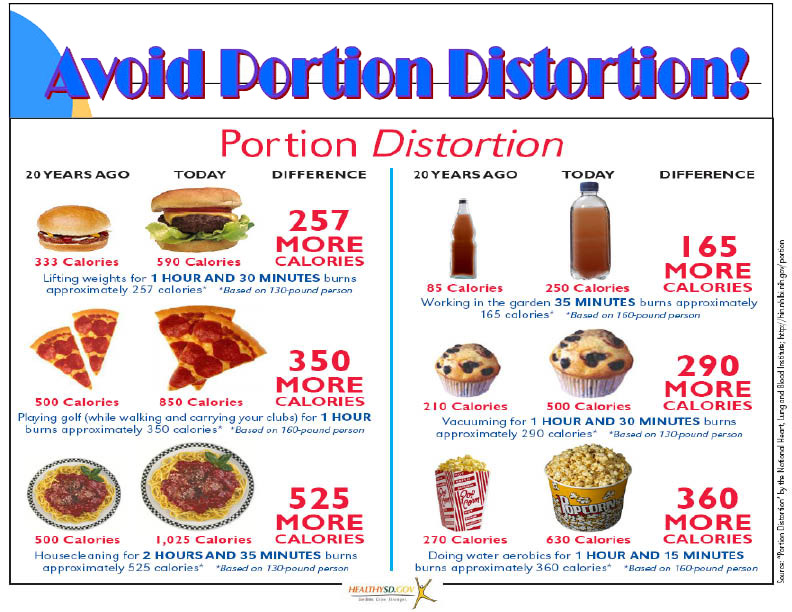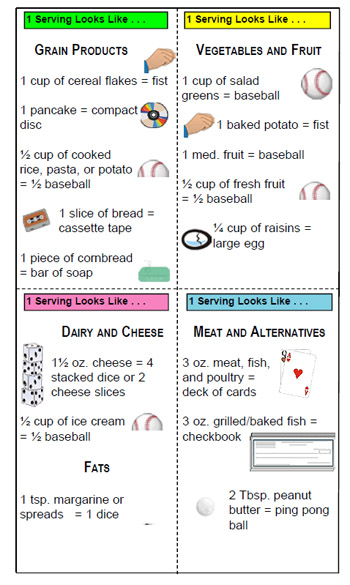
You do not need to measure and count everything you eat for the rest of your life—just do this long enough to recognize typical serving sizes. Try the ideas below to help you control portions at home:
- Take the amount of food that is equal to one serving, according to the food label, and eat it off a plate instead of eating straight out of a large box or bag.
- Avoid eating in front of the TV or while busy with other activities. Pay attention to what you are eating, chew your food well, and fully enjoy the smell and taste of your food.
- Eat slowly so your brain can get the message when your stomach is full.
- Try using smaller dishes, bowls, and glasses. Kitchen and eating utensils are much larger today than in decades past. Using smaller utensils is a way, when you fill up your plate or glass, to eat and drink less.
- Control your intake of higher-fat/sugar parts of a meal. Take seconds of vegetables and salads (watch the toppings and dressing) instead of desserts and dishes with heavy sauces.
- When cooking in large batches, freeze food that you will not serve right away. This way, you will not be tempted to finish eating the whole batch before the food goes bad. And you will have ready-made food for another day. Freeze leftovers in amounts that you can use for a single serving or for a family meal another day.
- Try to eat meals at regular times. Skipping meals or leaving large gaps of time between meals may lead you to eat larger amounts of food the next time you eat.
- When buying snacks, go for fruit or single-serving prepackaged items and foods that are lower-calorie options. If you buy larger bags or boxes of snacks, divide the items into single-serve packages right away so you won't be tempted to overeat.
- When you do have a treat like chips or ice cream, never eat directly from the container; measure out only one serving as shown by the food label. Eat only 1/2 cup of ice cream or 1 ounce of chips, eat them slowly, and enjoy them!
How can I control portions when eating out?
Research shows that the more often a person eats out, the more body fat he or she has. Try to prepare more meals at home. Eat out and get takeout foods less often.
- Check the menu for terms and icons that indicate healthy items, such as low-fat, low-calorie dishes.
- Share your meal, order a half-portion, or order an appetizer as a main meal. Examples of healthier appetizers include grilled or steamed seafood, minestrone soup, tomato or corn salsas, and vegetable salads with dressing on the side.
- Stop eating when you no longer feel hungry. It may take 15 minutes or longer for your stomach to signal to your brain that you are full. Put down your fork and focus on enjoying the setting and your friends or family for the rest of the meal.
- Avoid large beverages such as “super size” sugar-sweetened soft drinks. They have a large number of calories. Instead, try drinking water with a slice of lemon. If you want to drink soda, choose a calorie-free beverage or a small glass of regular soda. Other options are small glasses of slightly sweetened iced tea or lemonade.
- When Fast-Food is a must:

- Go Topless. Eat your favorite burger without the top bun; cuts a few calories.
- Before buying a “value combo, or combo meal” be sure you are making the best choice for your wallet and your health. If you are with someone else, share the large-size meal. If you are eating alone, skip the special deal and just order the smaller (healthier) size.
- Have you noticed that it only costs a few cents more to get larger sizes of fries or soft drinks at restaurants? Getting a larger portion of food for just a little extra money may seem like a good value, but you end up with more food and calories than you need for your body to stay healthy.
On the Road; Tips for Traveling:
- Pack a small cooler of foods that are hard to find on the road, such as fresh fruit, sliced raw vegetables, and fat-free or low-fat yogurt.
- Include a few bottles of water instead of sugar-sweetened soda or juice.
- Bring dried fruit, nuts, and seeds to snack on. Since these foods can be high in calories, measure and pack small portions (1/4 cup) in advance.
- If you stop at a restaurant, try to choose one that serves a variety of foods such as salads, grilled or steamed entrees, or vegetables.
- Consider drinking water or low-fat or fat-free milk instead of sugar-sweetened soft drinks with your meal.
- If you choose a higher-fat option like fries or pizza, order the small size. Or, you can ask for a single slice of pizza with vegetable toppings such as mushrooms or peppers.
Controlling Portions on a Budget:
Eating better does not have to cost a lot of money. Here are some ways you can keep track of your portions without adding extra costs to your grocery bill:- Buy meats in bulk. When you get home, divide the meat into single-serving packages and freeze for later use.
- Buy fruits and vegetables when they are in season. Buy only as much as you will use, so they will not go bad. Check out your local farmers market, as it may be less expensive than a grocery store.
- Watch your portion sizes. Try to stick to the serving sizes listed on the food label of prepackaged foods. Doing so can help you get the most out of the money you spend on that food. You can also better control the fat, sugar, sodium, and calories you eat.
- Stop eating out. Even just reducing your meals out by 1 or 2 times per week can save you about $15 - $25 per week. This is an easy way to save money and even have some extra to spend on higher quality foods.
- Cook large portions. It saves time to cook once and eat multiple times. One idea is to make a big pot of soup at the beginning of the week or whenever you go food shopping. When you don't feel like cooking, help yourself to a hearty bowlful along with a green salad. This makes a nutritious but inexpensive lunch or dinner anytime.
- Beware of hidden sugars. Most packaged or processed foods contain high levels of hidden sugar(s), or sugars with a multitude of different names. Processed foods may be easy to prepare and cheap, but too much sugar causes rapid swings in energy and blood sugar, and can contribute to many serious health problems. Check out the many different names of sugar found in processed/packaged foods. These are only a few!
U.S. Department of Health and Human Services